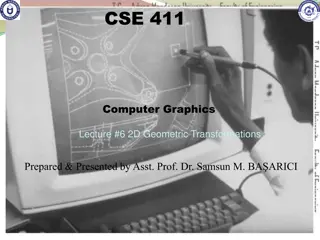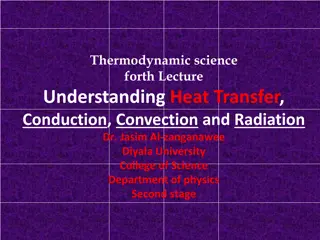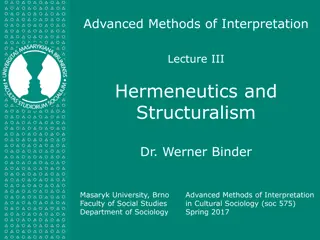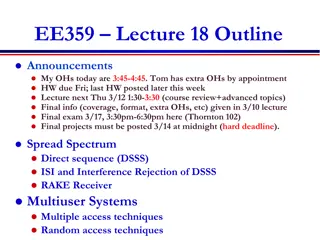
Digital Design Concepts and Implementations Overview
Understand digital design concepts like aliases, constants, and packages along with their syntax, features, and uses in FPGA programming. Learn the differences between explicit component declarations and package-based declarations for efficient code structuring and reuse.
Download Presentation

Please find below an Image/Link to download the presentation.
The content on the website is provided AS IS for your information and personal use only. It may not be sold, licensed, or shared on other websites without obtaining consent from the author. If you encounter any issues during the download, it is possible that the publisher has removed the file from their server.
You are allowed to download the files provided on this website for personal or commercial use, subject to the condition that they are used lawfully. All files are the property of their respective owners.
The content on the website is provided AS IS for your information and personal use only. It may not be sold, licensed, or shared on other websites without obtaining consent from the author.
E N D
Presentation Transcript
Aliases Syntax: ALIAS name : type := expression; Example: signal IR : std_logic_vector(31 downto 0); alias IR_opcode alias IR_reg1_addr : std_logic_vector(4 downto 0) is IR(25 downto 21); alias IR_reg2_addr : std_logic_vector(4 downto 0) is IR(20 downto 16); : std_logic_vector(5 downto 0) is IR(31 downto 26);
Constants Syntax: CONSTANT name : type := value; Examples: CONSTANT init_value : STD_LOGIC_VECTOR(3 downto 0) := "0100"; CONSTANT ANDA_EXT : STD_LOGIC_VECTOR(7 downto 0) := X"B4"; CONSTANT counter_width : INTEGER := 16; CONSTANT buffer_address : INTEGER := 16#FFFE#; CONSTANT clk_period : TIME := 20 ns; CONSTANT strobe_period : TIME := 333.333 ms;
Constants - Features Constants can be declared in a PACKAGE, ENTITY, ARCHITECTURE When declared in a PACKAGE, the constant is truly global, for the package can be used in several entities. When declared in an ARCHITECTURE, the constant is local, i.e., it is visible only within this architecture. When declared in an ENTITY declaration, the constant can be used in all architectures associated with this entity.
Explicit Component Declaration versus Package Explicit component declaration is when you declare components in main code When have only a few component declarations, this is fine When have many component declarations, use packages for readability Packages also help with portability and sharing of libraries among many users in a company Remember, the actual instantiations always take place in main code Only the declarations can be in main code or package 8
METHOD #2: Package component declaration Components declared in package Actual instantiations and port maps always in main code
Packages Instead of declaring all components can declare all components in a PACKAGE, and INCLUDE the package once This makes the top-level entity code cleaner It also allows that complete package to be used by another designer A package can contain Components Functions, Procedures Types, Constants 10
Package example (1) LIBRARY ieee ; USE ieee.std_logic_1164.all ; PACKAGE GatesPkg IS COMPONENT mux2to1 PORT (w0, w1, s : IN STD_LOGIC ; : OUT STD_LOGIC ) ; f END COMPONENT ; COMPONENT priority PORT (w: IN STD_LOGIC_VECTOR(3 DOWNTO 0) ; y : OUT STD_LOGIC_VECTOR(1 DOWNTO 0) ; z : OUT STD_LOGIC ) ; END COMPONENT ; 11
Package example (2) COMPONENT dec2to4 PORT (w: IN STD_LOGIC_VECTOR(1 DOWNTO 0) ; En : IN STD_LOGIC ; y : OUT STD_LOGIC_VECTOR(0 TO 3) ) ; END COMPONENT ; COMPONENT regn GENERIC ( N : INTEGER := 8 ) ; PORT ( D : IN DOWNTO 0) ; Enable, Clock Q : OUT DOWNTO 0) ) ; END COMPONENT ; STD_LOGIC_VECTOR(N-1 : IN STD_LOGIC_VECTOR(N-1 STD_LOGIC ; 12
Package example (3) constant ADDAB : std_logic_vector(3 downto 0) := "0000"; constant ADDAM : std_logic_vector(3 downto 0) := "0001"; constant SUBAB : std_logic_vector(3 downto 0) := "0010"; constant SUBAM : std_logic_vector(3 downto 0) := "0011"; constant NOTA : std_logic_vector(3 downto 0) := "0100"; constant NOTB : std_logic_vector(3 downto 0) := "0101"; constant NOTM : std_logic_vector(3 downto 0) := "0110"; constant ANDAB : std_logic_vector(3 downto 0) := "0111"; END GatesPkg; 13
Package usage (1) LIBRARY ieee ; USE ieee.std_logic_1164.all ; USE work.GatesPkg.all; ENTITY priority_resolver1 IS PORT (r : IN s : IN clk : IN STD_LOGIC; en : IN STD_LOGIC; t : OUT STD_LOGIC_VECTOR(3 DOWNTO 0) ) ; END priority_resolver1; STD_LOGIC_VECTOR(5 DOWNTO 0) ; STD_LOGIC_VECTOR(1 DOWNTO 0) ; ARCHITECTURE structural OF priority_resolver1 IS SIGNAL p : STD_LOGIC_VECTOR (3 DOWNTO 0) ; SIGNAL q : STD_LOGIC_VECTOR (1 DOWNTO 0) ; SIGNAL z : STD_LOGIC_VECTOR (3 DOWNTO 0) ; SIGNAL ena : STD_LOGIC ; 14
Package usage (2) BEGIN u1: mux2to1 PORT MAP ( p(0)); w0 => r(0) ,w1 => r(1),s => s(0), f => u2: mux2to1 PORT MAP ( p(3)); w0 => r(4) ,w1 => r(5),s => s(1),f => u3: priority PORT MAP (w => p, y => q, z => ena); u4: dec2to4 PORT MAP ( w => q, En => ena, y => z); u5: regn GENERIC MAP ( N => 4) PORT MAP ( D => z , Enable => En ,Clock => Clk, Q => t ); p(1) <= r(2); p(2) <= r(3); END structural; 15
Mixing Design Styles Inside of an Architecture
Mixed Style Modeling architecture ARCHITECTURE_NAME of ENTITY_NAME is Here you can declare signals, constants, types, etc. Component declarations begin Concurrent statements: Concurrent simple signal assignment Conditional signal assignment Selected signal assignment Generate statement Concurrent Statements Component instantiation statement Process statement inside process you can use only sequential statements end ARCHITECTURE_NAME; 18
PRNG Example (1) library IEEE; use IEEE.STD_LOGIC_1164.all; use work.prng_pkg.all; ENTITY PRNG IS PORT( Coeff Load_Coeff Seed Init_Run Clk Current_State END PRNG; : in std_logic_vector(4 downto 0); : in std_logic; : in std_logic_vector(4 downto 0); : in std_logic; : in std_logic; : out std_logic_vector(4 downto 0)); ARCHITECTURE mixed OF PRNG is signal Ands signal Sin signal Coeff_Q signal Shift5_Q : std_logic_vector(4 downto 0); : std_logic; : std_logic_vector(4 downto 0); : std_logic_vector(4 downto 0); 19
PRNG Example (2) -- Data Flow G: FOR I IN 0 TO 4 GENERATE Ands(I) <= Coeff_Q(I) AND Shift5_Q(I); END GENERATE; Sin <= Ands(0) XOR Ands(1) XOR Ands(2) XOR Ands(3) XOR Ands(4); Current_State <= Shift5_Q; END mixed; -- Behavioral Coeff_Reg: PROCESS(Clk) BEGIN IF Clk'EVENT and Clk = '1' THEN IF Load_Coeff = '1' THEN END IF; END IF; END PROCESS; -- Structural Shift5_Reg : Shift5 PORT MAP ( D => Seed, Sin => Sin, Clock => Clk, Q => Shift5_Q); Coeff_Q <= Coeff; Load => Init_Run,
References 1. https://ece.gmu.edu/coursewebpages/ECE/ECE545/F18/viewgraphs/ECE545_lecture_8_re gular.pdf



















